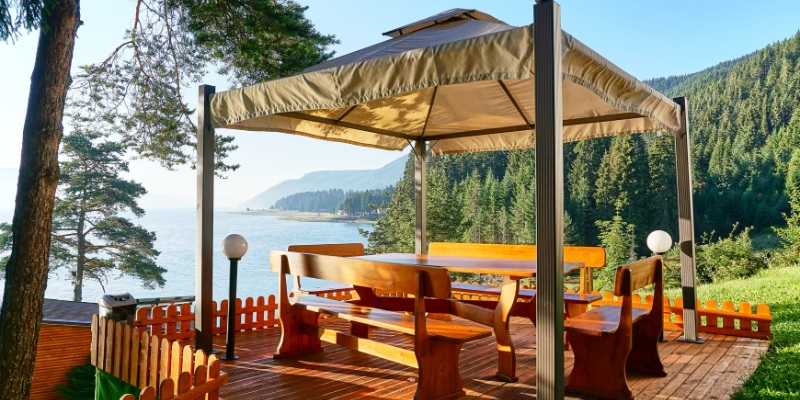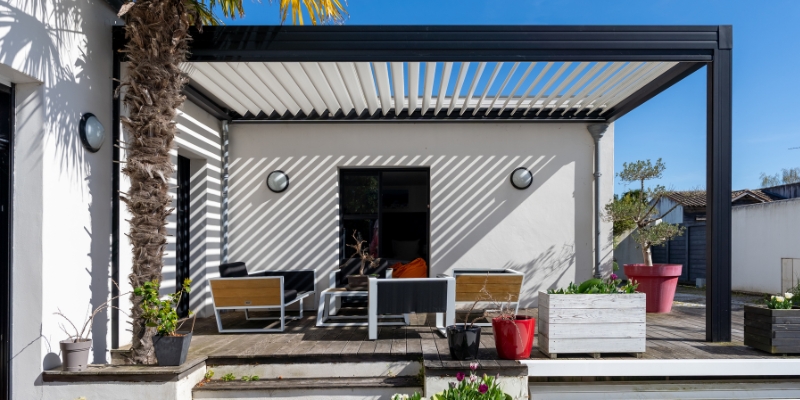
Ready to up your deck’s game with a stylish pergola? How to build a pergola on an existing deck?—you’ve asked, and we’re here to deliver the answers.
To cut to the chase, you can build a pergola on the deck by choosing the right material and securing your pergola posts directly to your deck’s framing or by creating a stable foundation for the pergola posts beneath the deck using concrete footings.
Stick around if you are thinking about building a pergola on deck, because we’re about to deep-dive into every crucial step, ensuring you get the deck-pergola combo of your dreams.
Can You Build A Pergola On A Deck? (Is It Advisable)
So, you’ve got the burning question – is it even advisable to build a pergola on an existing deck?
In general, yes, you can build a pergola on a deck.
Let’s quickly dig into the essentials.
First off, your deck framing and structure matter, a lot. If your deck is built with pressure-treated wood and has a robust joist structure, you’re on the right track.
But don’t skip the critical step of checking local building codes. These codes dictate essential parameters, ensuring your construction project stays within legal boundaries and, more importantly, remains safe.
Before you even think about main support beams and fabric panels, know the load-bearing capacity of your deck (multiply the deck’s area by 50 psf to determine its weight limit.).
Also, consult with professionals or your local building department to guarantee that your deck can handle the additional weight of a pergola.
Adding a pergola can transform your deck into an all-season gathering space, boosting not just the aesthetics but the functionality of your home’s outdoor living space.
How To Build a Pergola on Deck
Step 1: Assess Your Deck’s Framing and Structure
Before you start building assess your deck’s structure. Now, you might think your existing deck is sturdy—after all, it’s been holding up your barbecues and outdoor furniture for years, right?
But a pergola is a whole different ball game. It adds vertical load and lateral stress that your deck must be prepared to handle.
So, what are we talking about?
First, focus on your deck’s framing.
This is the skeleton of your deck and it needs to be strong. Inspect the deck joists, those horizontal supports that hold up the deck boards.
- Are they made from pressure-treated wood?
- Do they show any signs of wood rot or deterioration?
- You’ll want your joists to be in top-notch condition to support your future pergola structure.
And don’t just stop at a visual inspection.
Dive into the technicals, measure the load-bearing capacity. This might require a professional assessment, but it’s an investment that could save you a world of headaches later on. You need to ensure that your deck is not just visually appealing but also structurally sound.
Step 2: Choose your Pergola Materials and Fixings
This is the make-or-break moment where quality really counts. First off, let’s talk wood. Pressure-treated wood is a good bet for a long-lasting pergola.
Why?
It’s engineered to resist decay, repel insects, and stand up to all kinds of weather.
But wood isn’t your only concern. You’ll also need hardware to hold everything together. Opt for thick galvanized steel fasteners and timber bolts to ensure maximum security. These aren’t just any screws; they’re the linchpins that keep your pergola standing tall and proud.
Now, what if you’re keen on something modern and low-maintenance?
Consider an aluminum pergola kit. They’re lightweight, easy to assemble, and let’s be honest, they look pretty sleek. Plus, they offer the added benefit of requiring minimal upkeep compared to traditional wood structures.
They have all the essentials bundled together in the package required for a smooth installation of a pergola.
The right materials set the stage for a pergola that not only looks amazing but also lasts for years to come. Once you’ve got these in place, you’re well on your way to the next stage of your pergola adventure.
Step 3: Anchoring your Pergola Posts
Now comes the pivotal step. Nailing this step ensures that your pergola won’t just be a fair-weather friend – it’ll be a steadfast companion through wind, rain, and etc.
So, how do you anchor pergola posts?
The answer lies in creating a stable foundation for your pergola posts, right beneath your existing deck. We’re talking about concrete footings.
These aren’t your run-of-the-mill holes in the ground; they’re the bedrock your pergola will rely on for years to come.
To install, dig holes beneath the deck at the spots where your pergola’s posts will go. Then, place concrete piers fill them with concrete and let them set. Again, don’t forget to check local building codes for the exact depth and width requirements for your area.
Why concrete piers as footings?
Stability.
Think of them as the anchors that keep a ship from drifting in a storm. By attaching your pergola posts directly to these concrete footings, you’re making sure your pergola stands firm, come what may.
Here’s a pro tip:Use hot-dipped galvanized post anchors for added durability.
These aren’t your everyday anchors; they’re designed to resist corrosion and ensure that your pergola posts sit flush against the concrete, leaving zero room for wiggles or wobbles.
Step 4: Assembling the Rest of the Pergola Parts
The spotlight now shifts to the pergola’s louvers and main support beams – essentially, the bones of your pergola structure.
If you’ve opted for a wood pergola, joist hangers are your best friends here.
These hardware gems not only ensure that your beams sit securely but also simplify the whole assembly process. They provide that added layer of security, making sure your pergola is as sturdy as it is stunning.
And remember, this isn’t just any construction project; this is the creation of a personal gathering space that will host countless memories.
But what if you’ve gone the modern route with an aluminum pergola kit?
Well, here’s some good news. Once you’ve anchored the pergola posts on concrete footings, assembling the rest of the aluminum pergola structure is so straightforward, that you could practically do it single-handedly. These kits are engineered for ease, making it simpler than ever to bring your outdoor space to life.
Can You Install a Pergola on an Existing Deck?

Many homeowners ask this question, and the answer is a clear yes, you can install a pergola on an existing deck with a caveat.
The process will involve some additional steps to ensure the pergola’s structural integrity. The key is to anchor your pergola posts securely to concrete footings below the existing deck.
That means you’ll need to remove or cut through the existing deck boards in the spots where your pergola posts will stand.
Sounds daunting?
Don’t worry. With the right tools and some precise measurements, it’s a straightforward process.
Once you’ve created these openings in your deck, proceed with digging holes and setting your concrete footings as previously described. After ensuring these are securely anchored, you can then reinstall the deck boards you had removed.
The goal?
A seamlessly integrated pergola that makes your existing deck look like it was always meant to have this stunning addition.
How To Build A Pergola On A Deck Attached To A House?
What if your deck is attached to your house and you want your pergola to be, too? That’s a different ballgame, but certainly not out of reach.
In this scenario, you have two reliable options for anchoring your pergola: a Roof Riser System or a Ledger Board.
Using a Roof Riser System involves attaching the pergola to the roof structure of your home. This ensures that the weight of the pergola is safely distributed, keeping both your house and your pergola structurally sound.
On the other hand, a Ledger Board attaches the pergola to the sidewalls of your house, acting as a sturdy anchor that aligns your pergola perfectly with your home. Both methods provide reliable support, but you’ll need to carefully assess which option best suits your specific situation.
So, in cases where your deck is attached to your house, it’s critical to take mentioned additional steps.
How To Build A Pergola On A Raised Deck?
Riding high on the success of installing a pergola on a standard deck? But what if your deck is elevated? How do you build a pergola on a raised deck?
Believe it or not, the principles are largely the same but with a few crucial modifications.
Firstly, the height matters. With a raised deck, you’ll need taller posts to ensure the pergola posts height complements the elevation of your deck. Don’t overlook this; you’re aiming for architectural harmony here, not a lopsided eyesore.
Alternatively, you can raise the height of the concrete footings or piers above the ground.
Concrete footing blocks or piers need to meet the level of the raised deck to provide adequate support. This means your holes will need more concrete filling and your concrete footings taller, which might necessitate consultation with local building codes.
Once these tailored adjustments are made, the rest is familiar territory. Follow the instructions mentioned above for anchoring posts, choosing materials, and assembling your pergola.
Can You Anchor a Pergola Directly To a Deck Floor?
You’ve mastered the ins and outs of pergola installation, but there’s one question you may still have – can you anchor a pergola directly to a deck floor?
Before you start drilling holes, let’s dig into the reality.
The deck floor, while sturdy for everyday activities, is actually relatively thin and not engineered to bear the additional load of a freestanding pergola directly. The structure has to be reinforced for anchoring a pergola directly.
Think of it this way: A deck is designed to support a certain amount of weight per square foot, including furniture, people, and maybe a grill. When you add a pergola to the equation, the weight distribution changes dramatically. Plus, there’s the added stress from wind forces acting on the pergola’s vertical surfaces.
The consequence?
Your existing deck could become unstable, putting your new pergola and your loved ones at risk.
So to cut through the confusion – no, anchoring your pergola directly to the deck floor isn’t advisable without professional consultations. Stick with the tried-and-true method of securing your pergola posts to concrete footings below the deck.
Final Thoughts
Whether it’s an existing deck, a raised deck, or even a deck attached to your house, we’ve covered the bases. You’re now equipped with the know-how, from assessing your deck’s structural integrity to choosing the right materials and anchoring those all-important pergola posts.
We’ve even tackled those common questions and pitfalls to avoid, ensuring you’re on track to create not just a structure, but an extension of your home’s outdoor living space.
Remember, cutting corners is not an option here. Your pergola is as sturdy as its weakest link, be it the quality of wood, the depth of your concrete footings, or the strength of your fasteners. This isn’t just a weekend project; it’s a long-term investment in your outdoor lifestyle.
A well-built pergola can provide additional shade, create a focal point for decor, and most importantly, become a gathering spot with your loved ones in your own unique pergola space for years to come.


